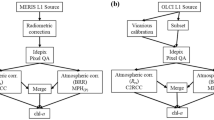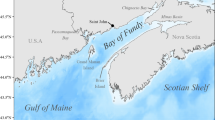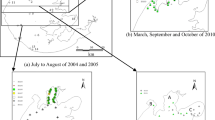Abstract
The accuracy and noise tolerance of 13 global models and 5 Case II chlorophyll a (chl a) retrieval models were evaluated using three dataset. It was found that if 5 % input noise related to atmospheric correction is considered, then the uncertainty associated with noise tolerance varied from 5.5 % to 55.6 %, and these uncertainties generally accounts for 15.63 % to 24.75 % of the total uncertainty. This observation suggests that an optimal algorithm not only should have a strong chl a concentration prediction ability but also should possess high insensitivity to the noise of remote-sensing imagery. The accuracy evaluations of chl a models were based on comparisons of chl a predicted models with chl a concentration measured analytically for field measurements. The results indicate that none of the selected chl a estimation algorithms provide accurate retrievals of chl a in turbid waters. This may be attributed to the strong optical influence of organic and inorganic matter at the blue green range, and the non-negligible of non-organic matter absorption at the red and near-infrared ranges. In order to solve this problem, the chl a concentration retrieval models must be further optimized. After being optimized using the empirical optimized method constructed in this paper, a single parameterized NDCI (normalized difference chl a index) model produces accurate retrievals in the Yellow River Estuary, Taihu Lake and Chesapeake Bay. If 5 % input noise associated with residual uncertainty 0of atmospheric correction is taken into account, the model produces only 29.96 % uncertainty for the remote sensing of chl a concentration in these three turbid waters.





Similar content being viewed by others
References
Aiken, J., Fishwick, J. R., Lavender, S., Barlow, R. B., Moore, G. F., Sessions, H., et al. (2007). Validation of MERIS reflectance and chlorophyll during the BENCAL cruise October 2002: Preliminary validation of new demonstration products for phytoplankton functional types and photosynthetic parameters. International Journal of Remote Sensing, 28, 497–516.
ASD (1999). Analytic Spectral Devices. Technical Guide, 3rd edition.
Carder, K. L., Chen, F. R., Lee, Z. P., Hawes, S. K., & Cannizzaro J. P. (2003). MODIS ocean science team algorithm theoretical basis document: Case 2 chlorophyll a. ATBD 19, Version 7.
Carder, K. L., Chen, F. R., Cannizzaro, J. P., Campbell, J. W., & Mitchell, B. G. (2004). Performance of the MODIS semi-analytical ocean color algorithm for chlorophyll-a. Advances in Space Research, 33, 1152–1159.
Chang, G. C., & Gould, R. W. (2006). Comparisons of optical properties of the coastal ocean derived from satellite ocean color and in situ measurements. Optics Express, 14(22), 10149–10163.
Chen, J., & Quan, W. T. (2013). An improved algorithm for retrieving chlorophyll-a from the Yellow River Estuary using MODIS imagery. Environmental Monitoring and Assessment, 185, 2243–2255.
Chen, J. X., Yu, C. H., & Jin, L. (2003). Mathematical analysis. Beijing: Higher Education Press.
Chen, J., Zhou, G. H., Wen, J. G., & Fu, J. (2010a). Effect of remotely sensed data errors on the retrieving accuracy of territorial parameters. Spectroscopy and Spectral Analysis, 30(5), 1347–1350.
Chen, J., Zhou, G. H., Wen, Z. H., & Fu, J. (2010b). Effect of remotely sensed data errors on the retrieving accuracy of territorial parameters. Spectroscopy and Spectral Analysis, 30(5), 1347–1350.
Chen, J., Fu, J., & Zhang, M. W. (2011a). An atmospheric correction algorithm for Landsat/TM imagery basing on inverse distance spatial interpolation algorithm: A case study in Taihu Lake. IEEE Journal of Selected Applied Earth Observation and Remote Sensing, 4(4), 882–889.
Chen, J., Wen, Z. H., & Xiao, Z. Q. (2011b). Spectral geometric triangle properties of chlorophyll-a inversion in Taihu Lake based on TM data. Journal of Water Resource and Projection, 3(1), 67–75.
Chen, J., Fu, J., & Sun, J. H. (2012). Using Landsat/TM imagery to estimating nitrogen and phosphorus concentration in Taihu Lake, China. IEEE Journal of Selected Applied Earth Observation and Remote Sensing, 5(1), 273–280.
Clavano, W. R., Boss, E., & Lee, K. B. (2007). Inherent optical properties of non-spherical marine-like particles—from theory to observation. Oceanography and Marine Biology, 45, 1–38.
Dall'Olmo, G., & Gitelson, A. A. (2005). Effect of bio-optical parameter variability on the remote estimation of chlorophyll-a concentration in turbid productive waters: Experimental results. Applied Optics, 44, 412–422.
George, D. G. (1997). The airborne remote sensing of phytoplankton chlorophyll-a in the lakes and tarns of the English Lake District. International Journal of Remote Sensing, 18(9), 1961–1975.
Gilerson, A. A., Gitelson, A. A., Zhou, J., Gurlin, D., Moses, W., & Joannou, I. (2010). Algorithms for remote estimation chlorophyll-a in coastal and inland waters using red and near-infrared bands. Optical Express, 18, 24109–24125.
Gilpin, L., & Tett, P. (2001). A methods for analysis of benthic chlorophyll-a pigment, In Marine biology report, 326–341. UK: Napier University Press.
Gitelson, A. A. (1992). The peak near 700 nm on reflectnce spectra of algae and water: Relationships of its magnitude and position with chlorophyll concentration. Internal Journal of Remote Sensing, 13, 3367–3373.
Gitelson, A. A., Dall'Olmo, G., Moses, W., Rundquist, D. C., Barrow, T., Fisher, T. R., et al. (2008). A simple semi-analytical model for remote estimation of chlorophyll-a in turbid waters: Validation. Remote Sensing of Environment, 112, 3582–3593.
Gons, H. J., Rijkeboer, M., Bagheri, S., & Ruddick, K. G. (1999). Optical teledection of chlorophyll a in estuarine and coastal waters. Environmental Science and Technology, 34, 5189–5192.
Gons, H. J., Auer, M. T., & Effler, S. W. (2008). MERIS satellite chlorophyll mapping of oligotrophic and eutrophic waters in the Laurentian Great Lakes. Remote Sensing of Environment, 112, 4098–4106.
Gordon, H. R., & Franz, B. A. (2008). Remote sensing fo ocean color: Assessment of the water-leaving radiance bidirectional effects on the atmospheric diffuse transmittance for SeaWiFS and MODIS intercomparisons. Remote Sensing Environment, 112, 2667–2685.
Gordon, H. R., & Voss K. J. (1999). MODIS normalized water-leaving radiance algorithm theoretical basis document. NASA Technic Document. Under Contract Number NAS5-31363, Version 4.
Hu, C., Carder, K. L., & Muller-Karger, F. E. (2001). How precise are SeaWiFS ocean color estimates? Implications of digitization-noise errors. Remote Sensing Environment, 76, 239–249.
Hyde, K. J. W., O'Reilly, J. E., & Oviatt, C. A. (2007). Validation of SeaWiFS chlorophyll a in Massachusetts Bay 2007. Remote Sensing of Environment, 27, 1677–1691.
Leathers, R. A., & McCormick, N. J. (1997). Ocean inherent optical properties estimation from irradiances. Applied Optics, 36(33), 8685–8699.
Lee, Z. P., Carder, K. L., & Arnone, R. A. (2002). Deriving inherent optical properties from water color: A multi-band quasi-analytical algorithm for optically deep waters. Applied Optics, 41(27), 5755–5772.
Marriari, M., Hu, M. C., & Daly, K. (2006). Validation of SeaWiFS chlorophyll a concentrations in the South Ocean: A revisit. Remote Sensing of Environment, 105, 367–375.
Matthews, M. W. (2011). A current review of empirical procedures of remote sensing in inland and near-coastal transitional waters. International Journal of Remote Sensing, 32(21), 6855–6899.
Mishra, S., & Mishra, D. R. (2012). Normalized difference chlorophyll index: A novel model for remote estimation of chlorophyll-a concentration in turbid productive waters. Remote Sensing of Environment, 117, 394–406. doi:10.1016/j.rse.2011.10.016.
Moore, T. S., Campbell, J. W., & Dowell, M. D. (2009). A class-based approach to characterizing and mapping the uncertainty of the MODIS ocean chlorophyll product. Remote Sensing of Environment, 113, 2424–2430.
Morel, A., & Prieur, L. (1977). Analysis of variances in ocean color. Limnology and Oceanography, 22, 709–722.
Moses, W., Gitelson, A. A., Berdnikov, S., & Povazhnyi, V. (2009). Satellite estimation of chlorophyll-a concentration using the red and NIR bands of MERIS—the Azov Sea case Study. IEEE Geoscience and Remote Sensing Letters, 6(4), 845–849.
Mueller, J. L., & Fargion, G. S. (2002). Ocean optics protocols for satellite ocean color sensor validation, Revision 3. SeaWiFS Technical Report Series (Part II):171–179.
Mueller, J. L., Davis, C. O., Arnone, R. A., Frouin, R., Carder, K. L., Lee, Z. P., Steward, R. G., Hooker, S., Mobley, C. D., & McClain C. R. (2003). Above-water radiance and remote sensing measurement and analysis protocols. Ocean optics protocols for satellite ocean-color sensor validation revision 4: Vol. III. Radiometric measurements and data analysis protocols. NASA Technical Memorandum 2003–21162.
O'Reilly, J. E., Maritorena, S., Mitchell, B. G., Siegcl, D. A., Carder, K. L., & Garver, S. A. (1998). Ocean color chlorophyll algorithms for SeaWiFS. Journal of Geophysical Research, 103(11), 937–953.
Ruddick, K. G., Gons, H. J., Rijkeboer, M., & Tilstone, G. (2001). Optical remote sensing of chlorophyll a in case II waters by use of an adaptive two-band algorithm with optimal error properties. Applied Optics, 40, 3575–3585.
Smyth, T. J., Moore, G. F., Hirata, T., & Aiken, J. (2006). Semi-analytical model for the derivation of ocean color inherent optical properties: Description, implementation, and performance assessment. Applied Optics, 45(31), 8116–8132.
Spyrakos, E., Vilas, L. G., Torres Palenzuela, J. M., & Barton, E. D. (2011). Remote sensing chlorophyll a of optically complex waters (rias Baixas, NW Spain): Application of a regionally specific chlorophyll a algorithm for MERIS full resolution data during an upwelling cycle. Remote Sensing of Environment, 115, 2471–2485. doi:10.1016/j.rse.2011.05.008.
Szeto, M., Werdell, P. J., Moore, T. S., & Campbell J. W. (2011). Are the world's oceans optically different. Journal of Geophysical Research 116. doi:10.1029/2011JC007230.
Tassan, S., & Ferrari, G. M. (2003). Variability of light absorption by aquatic particles in the near-infrared spectral region. Applied Optics, 42(24), 4802–4810.
Tilstone, G. H., Angel-Benavides, I. M., Pradhan, Y., Shutler, J. D., Groom, S., & Sathyendranath, S. (2011). An assessment of chlorophyll-a algorithms available for SeaWiFS in coastal and open areas of the Bay of Bengal and Arabian Sea. Remote Sensing Environment, 115, 2277–2291.
Tzortziou, M., Herman, J. R., Gallegos, C. L., Neale, P. J., Subramanian, A., Harding, L. W., et al. (2006). Determination of chlorophyll contentand tropic state of lakes using field spectrometer and IRS-IC satellite data in the Mecklenburg Lake Distract, Germany. Remote Sensing of Environment, 73, 227–235.
Tzortziou, M., Subramanian, A., Herman, J. R., Gallegos, C. L., Neale, P. J., & Harding, L. W. (2007). Remote sensing reflectancec and inherent optical properties in the mid Chesapeake Bay. Estuarine, Coastal and Shelf Science, 72, 16–32.
Wang, M., Shi, W., & Tang, J. (2011). Water property monitoring and assessment for China's inland Lake Taihu from MODIS-Aqua measurements. Remote Sensing of Environment, 115, 841–854. doi:10.1016/j.rse.2010.11.012.
Acknowledgements
This study is supported by the China State Major Basic Research Project (2013CB429701), Projects of International Cooperation and Exchanges of National Natural Science Foundation of China (41210005), Science Foundation for 100 Excellent Youth Geological Scholars of China Geological Survey, Serial Maps of Geology and Geophysics on China Seas and Land on the Scale of 1:1000000 (200311000001), and the Public Science and Technology Research Funds Projects of Ocean (201005030). We would like to just express our gratitude to two anonymous reviewers for their useful comments and suggestions.
Author information
Authors and Affiliations
Corresponding author
Rights and permissions
About this article
Cite this article
Chen, J. Noise tolerance of algorithms for estimating chlorophyll a concentration in turbid waters. Environ Monit Assess 186, 2297–2311 (2014). https://doi.org/10.1007/s10661-013-3538-z
Received:
Accepted:
Published:
Issue Date:
DOI: https://doi.org/10.1007/s10661-013-3538-z




